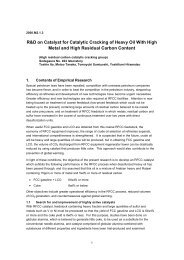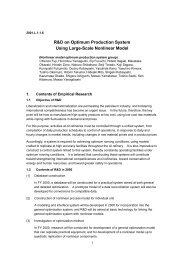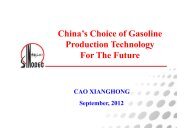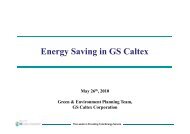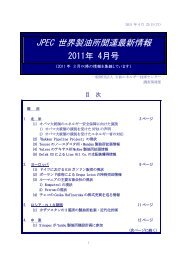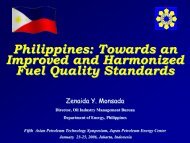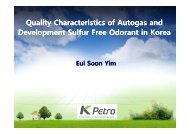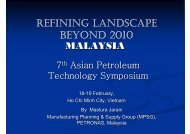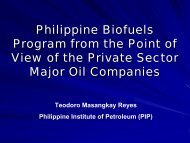R&D on Hydrogen Production by Autothermal Reforming
R&D on Hydrogen Production by Autothermal Reforming
R&D on Hydrogen Production by Autothermal Reforming
You also want an ePaper? Increase the reach of your titles
YUMPU automatically turns print PDFs into web optimized ePapers that Google loves.
3.4 Investigati<strong>on</strong> of Hydrocarb<strong>on</strong> C<strong>on</strong>stituents in Fuel and of <strong>Autothermal</strong> <strong>Reforming</strong><br />
Characteristics<br />
3.4.1 Experiment Method<br />
A fixed-bed, flow-type micro reactor was used for reacti<strong>on</strong>s. The hydrocarb<strong>on</strong> compounds<br />
shown in Table 3.4.1 were used as raw material, together with standard ATR catalyst A. So as<br />
to compare the autothermal reforming reacti<strong>on</strong> characteristics am<strong>on</strong>g each hydrocarb<strong>on</strong>, the<br />
most ideal reacti<strong>on</strong> temperature was <strong>on</strong>e at which side reacti<strong>on</strong>s such as combusti<strong>on</strong> or<br />
decompositi<strong>on</strong> could be suppressed as much as possible. Representative of each hydrocarb<strong>on</strong>,<br />
deep desulfurized kerosene and normal hexane were taken as raw materials. Reacti<strong>on</strong> was<br />
initiated under the same c<strong>on</strong>diti<strong>on</strong>s as for autothermal reforming reacti<strong>on</strong>, using a micro-reactor<br />
without catalyst, and the presence of side reacti<strong>on</strong>s in the reactor was c<strong>on</strong>firmed. As shown in<br />
Figure 3.4.1, because the C2-C4 hydrocarb<strong>on</strong> selecti<strong>on</strong> rate is zero at 600°C or below, it was<br />
c<strong>on</strong>firmed that no side reacti<strong>on</strong>s take place inside the reactor. C<strong>on</strong>sequently, autothermal<br />
reforming reacti<strong>on</strong> was implemented at 600°C, where there would be no side reacti<strong>on</strong>s. Taking<br />
the carb<strong>on</strong> mol flow volume included in the raw material hydrocarb<strong>on</strong>s as standard, the rate was<br />
0.71 mol/hr-C. O2/C and S/C were determined in accordance with Secti<strong>on</strong> 3.1.2. <strong>Reforming</strong><br />
reactivity was evaluated using a virtual speed c<strong>on</strong>stant k (CO + CO2) covering CO + CO2<br />
producti<strong>on</strong>, determined <strong>on</strong> the assumpti<strong>on</strong> of a primary reacti<strong>on</strong> and CO + CO2 selecti<strong>on</strong> rate<br />
that correlates with the hydrogen selecti<strong>on</strong> rate targeted.<br />
Table 3.4.1: Model Hydrocarb<strong>on</strong> Compounds Equivalent to Naphtha -<br />
Kerosene Fracti<strong>on</strong>s Used<br />
Hydrocarb<strong>on</strong><br />
count<br />
n-P i-P O N A<br />
LN 6 n-hexane 2,2<br />
dimethylbutane<br />
1-hexane cyclohexane benzene<br />
HN 8 n-octane 2,2,4-trimethylp 1-octane ethylcyclohexane m-xylene<br />
entane<br />
ethylbenzene<br />
KERO 10 n-decane n-butylcyclohexane diethylbenzene<br />
Other n-dodecane,<br />
n-hexadecane<br />
C2-C4 selecti<strong>on</strong> rate (%)<br />
10<br />
Desulfurized kerosene<br />
Reacti<strong>on</strong> temperature (°C)<br />
(Reacti<strong>on</strong> c<strong>on</strong>diti<strong>on</strong>s: O2/C = 0.45, S/C heat balance c<strong>on</strong>diti<strong>on</strong>s, LHSV = 1.0 to 1.6)<br />
Figure 3.4.1: Temperature Dependency vs Side Reacti<strong>on</strong> in Reactor<br />
1,2,4-trimethylbenzene




